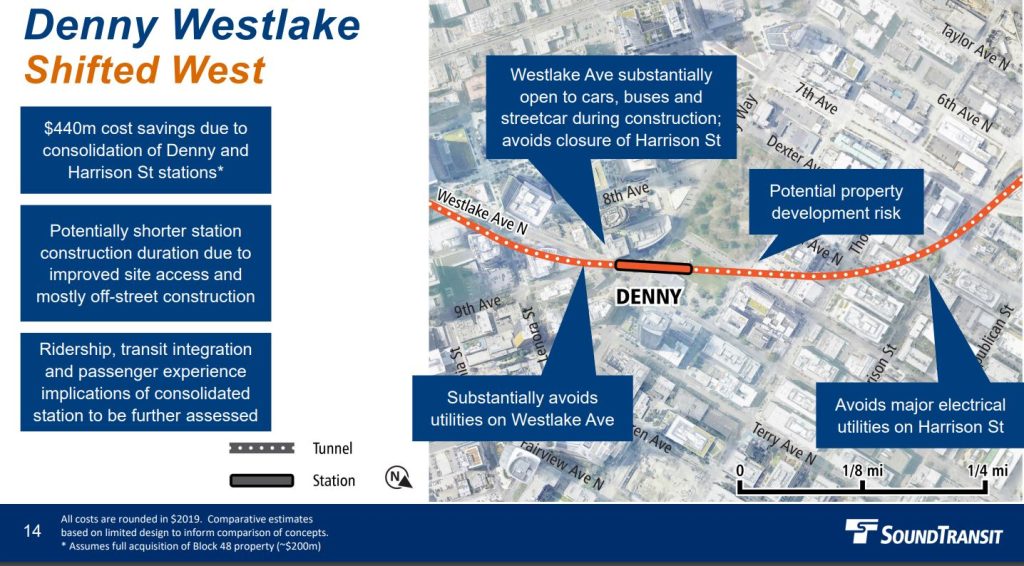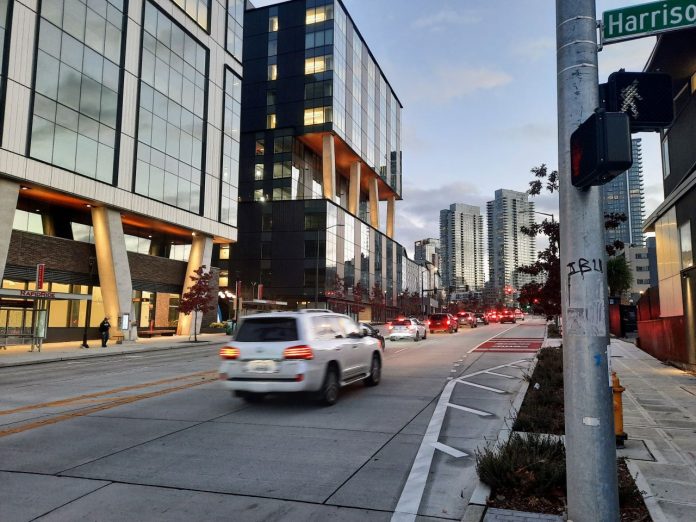
On Thursday, the Sound Transit System Expansion Committee will receive an update on the Denny and South Lake Union stations, two stations on the planned Ballard Link Extension. The update comes only three months after a tumultuous decision on locating the Denny station that risked loss of the corresponding South Lake Union station. Thursday’s agenda suggests that another alternative may be coming forward for South Lake Union, but the details are opaque at this time.
The agenda offers some deep Sound Transit speak: “Potential action to direct staff to present an action to the System Expansion Committee in December to assess the feasibility of an additional alternative in the South Lake Union area for potential inclusion in the Draft Environmental Impact Statement for the Ballard Link Extension project, as well as any associated budget and contract amendments for project development work, so the committee can consider forwarding said actions to the Board,” the item reads.
As cryptic as that may all sound, there are some clues about what’s ahead. The push earlier this year to re-site the Denny station was driven by pushback from the business community, led by Amazon and Vulcan, who own or operate nearby properties. That in turn affected the neighboring South Lake Union station, since as locations got closer together and turn geometry tighter something had to give. As a consequence, the board had some discussion of shifting South Lake Union Station west to pair with more westerly locations for Denny. That could be what Thursday’s presentation dives into.
Adding yet another option to study this late in the game again could have serious implications for decision and construction timelines — not to mention the quality of a line being designed in such a piecemeal fashion. Sound Transit has delayed Ballard Link’s expected opening four years to 2039 as planning has sputtered.
With that in mind, it’s worth retracing steps to how the process got here.
Over the summer, Amazon and Vulcan came out against Denny Westlake station options that would secure a companion South Lake Union station, despite strong public support for both stations. The companies instead backed a newly surfaced Denny “Shifted West” option that would have a station under portions of the 9th Avenue stub, Denny Way, and the Denny Playfield. This location would keep the station off of Westlake Avenue, but at the cost of building the South Lake Union. That’s because the station location would complicate geometry as the tunnel curves toward Uptown and put the Denny station very close to the intended South Lake Union station at Harrison Street and 7th Avenue N.
Sound Transit had looked at another location for the South Lake Union station, situated around Harrison Street and 5th Avenue N. But at the July board meeting, Cathal Ridge, head of the Ballard Link Extension, said that it would have to go on the Memorial Stadium site, which is planned for a rebuild slated for completion in 2026, which appeared to be a non-starter.
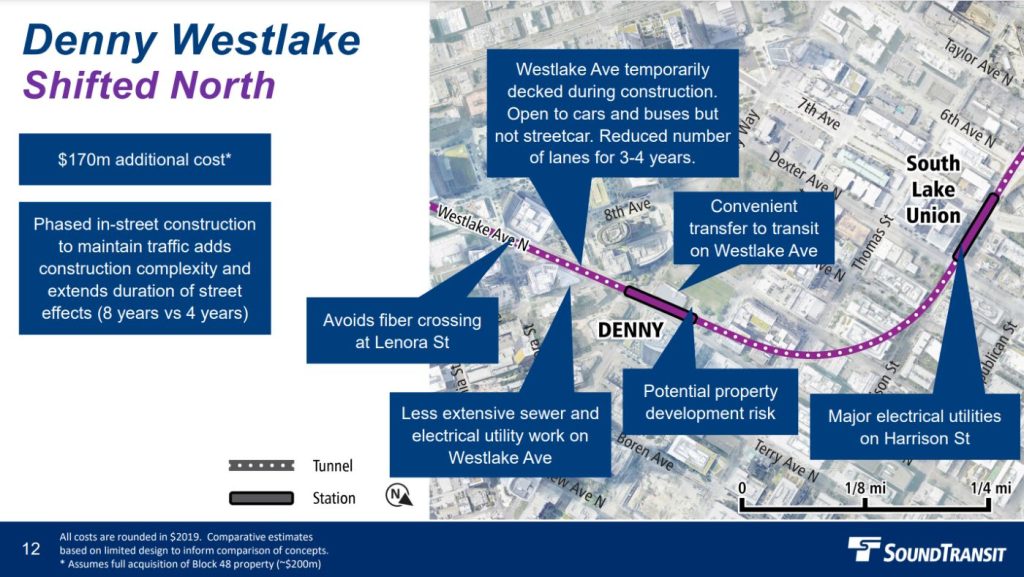
At the meeting, Seattle Mayor Bruce Harrell tried to ameliorate business concerns surrounding the previously preferred Denny Westlake (DT-1) alternative while securing the South Lake Union station by supporting the Denny Westlake Shifted North option, even though it was estimated to cost $170 million more. Denny Westlake Shifted North, as the name suggests, moves the station location a little further north from Denny Westlake (DT-1) that was planned on Westlake Avenue between Blanchard and Lenora Streets.
The Denny Westlake Shifted North station, if built, would be constructed partially within the Westlake Avenue right-of-way and partially on private property, providing the start of a curve to the northwest to reach the following station. The station would straddle Denny Way with a portion of it sliding just to its south but mostly situated on the north side. Mitigating traffic impacts, as modest as they would be for drivers, the street would be decked to provide relatively unimpeded flow while constructing the station below and on private property. The South Lake Union Streetcar, however, may need to be suspended during construction if temporary tracks couldn’t be installed.
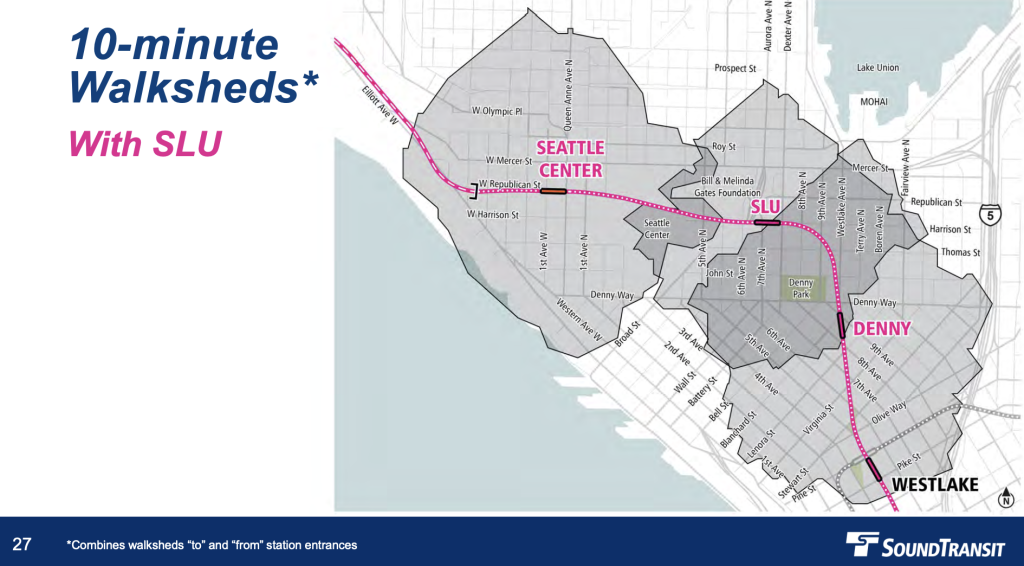
Building a South Lake Union station is not only viewed as complimentary to adjacent stations, but also a critical linchpin for the light rail extension in Seattle, as Harrell told the board. That’s because the agency projects the station would serve 10,000 riders per day, would provide a key transfer point for bus riders, and would serve existing and rapidly growing mixed-use areas of Uptown and South Lake Union. The station would also act as a relief station for Climate Pledge Arena and Seattle Center events while supporting Memorial Stadium and other Seattle Center attractions like MoPOP and the Space Needle.
During the July board meeting, Snohomish County Executive Dave Somers opposed Harrell’s preferred station proposal, arguing instead for consolidation of the Denny and South Lake Union stations by way of the Denny Westlake Shifted West station location. Somers said that the sacrifice was worth it even though it would mean pushing about 8,000 Link boardings to sluggish buses navigating congested streets in the area. Using some unorthodox accounting to justify his position, Somers said consolidation would save $600 million — dollars that wouldn’t even come from his subarea.
King County Councilmember Claudia Balducci countered Somers’ inventive math.
“It’s a little wrong to suggest that the gap between our preferred alternative and this is $600 million, the gap is far less than that,” Balducci said. “The only way you get to $600 million is to assume that Denny Westlake Shifted West was our preferred alternative — and it never was — and then say we’re forgoing the cost savings of deleting a station. And let me just say, with that kind of logic, we shouldn’t build any stations, we’d save a ton of money.”
After extensive debate, the board affirmed Harrell’s proposed Denny Westlake Shifted North option as the preferred alternative for the Draft Environmental Impact Statement (EIS) process. Denny Westlake Shifted West only made it into the Draft EIS as a non-preferred alternative to be studied.
Because of how Sound Transit is performing its Draft EIS process, only preferred alternatives will be rigorously studied and advanced to preliminary engineering. That makes it highly likely that the Denny Westlake Shifted North alternative will advance into the Final EIS and engineering, along with the South Lake Union station at Harrison Street and 7th Avenue N.
Nevertheless, it appears Amazon and Vulcan have remained adamant in trying to shift the Denny Westlake station west with the hope of keeping it off of Westlake Avenue, an arterial street with relatively modest traffic volumes according to City traffic studies. In fact, south of Blanchard Street, just 4,500 vehicles per day used Westlake Avenue in 2018, which the Seattle Department of Transportation says is the most recent traffic data it has.
What will be unveiled on Thursday exactly is not entirely clear at the moment, but the tea leaves strongly suggest that a further change of the Draft EIS could be coming with a South Lake Union station located further to the west. How such a station would work will certainly be of deep interest to many, but at the July board meeting, Don Billen, Sound Transit’s planning director, was fairly sour that there’s a practical solution.
“If the ask is ‘go search for an alternative that both shifts the Denny station west and also finds the location that we have not been able to find yet for shifting [the South Lake Union station] west,’ that will be both additional time and additional money,” Billen said. New alternatives take about six to nine months to develop, according to Billen.
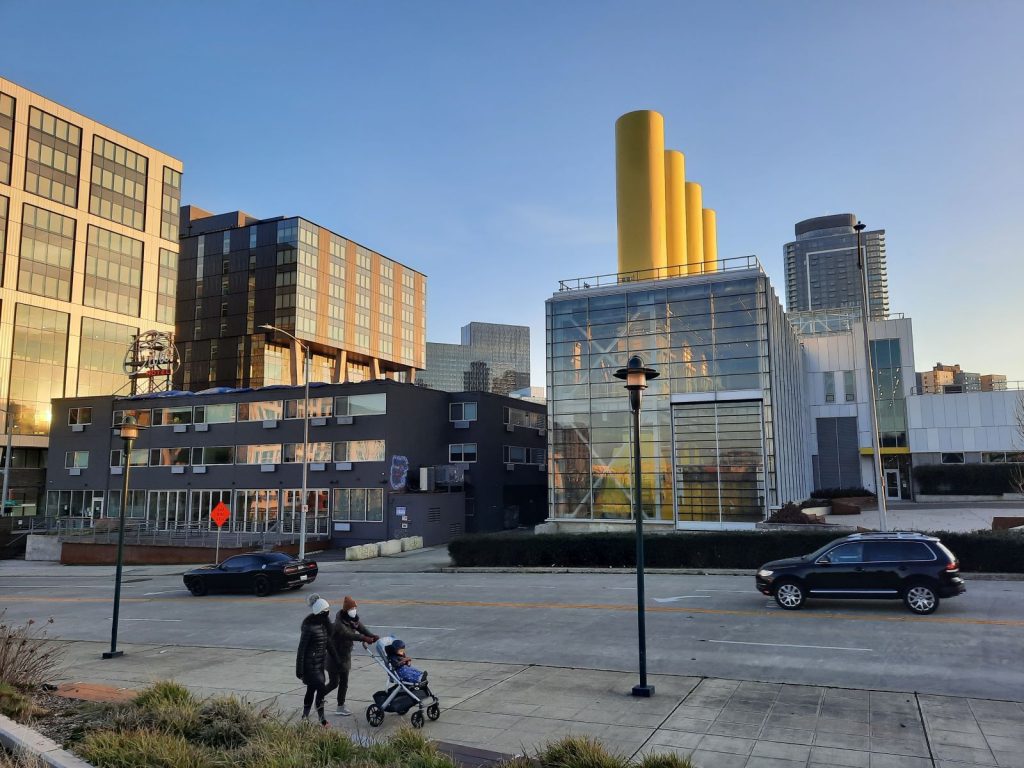
Beyond where the station would be located, it raises several critical questions around how it would integrate with north end buses, whether the alternative would become a preferred alternative or a non-preferred alternative, and if just the latter, whether or not it would get deeper analysis through preliminary engineering like preferred alternatives.
Should the alternative South Lake Union become preferred or get deeper analysis than non-preferred alternatives, it would give renewed justification for transit advocates to demand equity and similar treatment of Chinatown’s 4th Avenue Shallower station alternative, which isn’t getting preliminary engineering, putting it at a disadvantage versus the agency’s preferred alternative of having Ballard Link skip Chinatown and Midtown.
Ultimately, Thursday’s briefing on the Denny and South Lake Union stations has the potential to once again drastically change the Ballard Link landscape or just be a nothing-burger.
Stephen is a professional urban planner in Puget Sound with a passion for sustainable, livable, and diverse cities. He is especially interested in how policies, regulations, and programs can promote positive outcomes for communities. With stints in great cities like Bellingham and Cork, Stephen currently lives in Seattle. He primarily covers land use and transportation issues and has been with The Urbanist since 2014.

